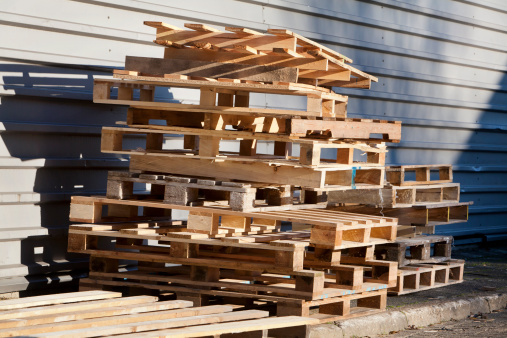You’ve been working with pallets for years. You’ve bought them, re-used them and repaired them, meeting the demand for outbound shipments. Over time, you’ve accumulated pallets that simply can’t be used and are taking up space in your yard. Hesitant to send them to the landfill in a dumpster or, worse, let the pile grow in your yard? Don’t sweat it: there are multiple ways to recycle wood pallets, all of which are environmentally clean, financially sound, and helpful for others.
- Energy Recovery. For anyone with stores of pallets leftover during the winter, burning pallets for heating purposes is a great way to conserve energy costs and make use of old pallets. Be careful, though—avoid burning pallets that have been chemically treated, because the toxins released can be harmful to both you and the environment. Most pallets are heat-treated rather than chemically treated, so burning normally isn’t a problem.
- Landscape Mulch. Natural mulch is one of the best uses for recycled pallets. In addition to emitting a pleasant earthy smell in a garden, mulch helps seal in moisture for growing plants and protects them from extreme temperatures. Pallet mulch is completely organic, meaning it decomposes naturally and even looks nice in a garden — natural reds and browns complement greenery much better than inorganic mulches.
- Soil Enhancement. While mulch is used more for landscaping, it can also be used to enhance soil in green spaces. Naturally colored mulch is used in forest pathways and backyards to protect soil from harsh weather conditions and moisture, which keeps it healthy, regardless of whether it’s clay-based or light, earthy soil.
- Wood Particleboard. Many pallet recycling plants separate the pallets from the metal nails, creating wood chips ready-set for a second life as furniture, walls, or even more pallets. Particleboard is a dense type of engineered wood created from compressed wood chips and is often used to create inexpensive wood furniture—think of IKEA as a prime example.
- Compressed Wood Pallets. Certain manufacturers have designed new styles of pallets made from particleboard: they’re lighter, more ergonomically designed, and just as sturdy as regular pallets. They’re also exempt from ISPM 15 regulations because they’re created using glue, heat, and pressure.
- Bonus: Interior Design. “Shabby chic” is in, haven’t you heard? Pallet sofas, pallet shoe racks, pallet bedframes, and pallet shelves have skyrocketed in popularity. A popular pastime for frugal or DIY designers, it’s possible to strip apart a pallet and create an entire living room set out of it. See Pinterest for details.
There’s no reason useable lumber should wind up in a dumpster. Even if your pallets have lived a good life and are now beyond repair, to simply throw them out without first considering green options would be a financial and environmental mistake. There are plenty of options that lie comfortably between the extremes of the trash can and allowing the pile of discarded pallets to consume space in your yard: it’s just a matter of which route you choose.
